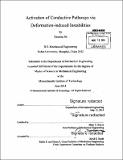Activation of conductive pathways via deformation-induced instabilities
Author(s)
Ni, Xinchen
DownloadFull printable version (13.37Mb)
Other Contributors
Massachusetts Institute of Technology. Department of Mechanical Engineering.
Advisor
Mary C. Boyce
Terms of use
Metadata
Show full item recordAbstract
Inspired by the pattern transformation of periodic elastomeric cellular structures, the purpose of this work is to exploit this unique ability to activate conductive via deformation-induced instabilities. Two microstructural features, the contact nub and the conductive pathway, are introduced to make connections within the void and between the voids upon pattern transformation. Finite element-based micromechanical models are employed to investigate the effects of the contact nub geometries, conductive pathway patterns and elastic properties of the coating and substrate materials on the buckling responses of the structure. Finally, a flexible circuit that can be switched on and off by an applied uniaxial load is fabricated based on the finite element analysis and demonstrated the ability to activate conductive pathways in response to an external triggering stimulus.
Description
Thesis: S.M., Massachusetts Institute of Technology, Department of Mechanical Engineering, 2014. "June 2014." Cataloged from PDF version of thesis. Includes bibliographical references.
Date issued
2014Department
Massachusetts Institute of Technology. Department of Mechanical EngineeringPublisher
Massachusetts Institute of Technology
Keywords
Mechanical Engineering.